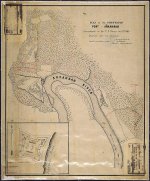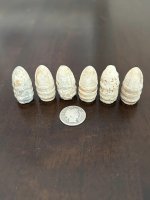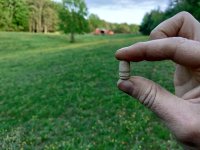Gypsy Heart
Gold Member
In 1686, Henri de Tonti established a trading post known as "Poste de Arkansea" at the Quapaw village of Osotouy. It was the first semi-permanent French settlement in the lower Mississippi River Valley. The establishment of the Post was the first step in a long struggle between France, Spain, and England over the interior of the North American continent.
Over the years, the Post relocated as necessary due to flooding from the Arkansas River, but its position always served of strategic importance for the French, Spanish, American, and Confederate military. Spanish soldiers and British partisans clashed here in the 1783 "Colbert Incident," the only Revolutionary War action in Arkansas.
Arkansas Post became part of the United States during the Louisiana Purchase of 1803. By 1819, the post was a thriving river port and the largest city in the region and selected the capital of the Arkansas Territory.
During the Civil War, Confederate troops tried to maintain tactical control of the confluence of the two rivers, and in 1862 they constructed a massive earthen fortification known as Fort Hindman. In January 1863 Union troops destroyed the fort and adjacent river port town, ensuring control of the Arkansas River.
..........................
The oldest documents owned by the Arkansas History Commission and State Archives are French Louisiana records purchased from France that cover the time frame 1680 to 1800. Some of the other early papers on file include " Matrimonios De Blanco," which loosely translated is "White Marriages," those that took place at "Poste de Arkansea" from 1791 to 1840.
...............................................
De Tonti established a trading post, staffed with six on the north side of the Arkansas River, adjacent to the Quapaw village of Osotouy. A cabin and a large cross were erected. It was named “Poste de Arkansea”.
1687 March La Salle is assassinated by one of his own men. His Texas settlement fails in the following months.
July 24 Survivors of La Salle's expedition to Texas, come across Arkansas Post while making their way north. One of the party, Henri Joutel, later writes the first description of the Post.
By this time only two men remain at the Post. The other four returned to Canada for news and supplies.
1689 A site was granted to Father Claude Deblon, a Jesuit priest, for a chapel and mission at the Post. It is highly likely that this chapel was never developed.
1690 While traveling the Mississippi River, Henri de Tonti makes a short visit to Arkansas Post. This may be the only time he visited the settlement that he helped to create.
1700 At about this date the original Poste de Arkansea was abandoned
.....................................
Around 1682, Robert Cavelier, Sieur de la Salle claimed much of the central interior of North America for France with a vision of establishing trading post up and down the Mississippi River . When la Salle visited the Arkansas 1682 as he and Henri de Tonty explored down the Mississippi River and up the Arkansas River, the local Quapaw Indians knew Arkansas as Arkansea. It was at this time that Henri de Tonty, one of la Salle's lieutenants, asked for a piece of the area found by la Salle and himself while traveling part of the way up the Arkansas River (United States). La Salle granted him the wish, and in August of 1686, de Tonty settled ten of his men near the Quapaw village of Osotouy about thirty-five miles from the mouth of the Arkansas . Arkansas Post was the first European settlement in what would later become Jefferson's Louisiana Purchase, and for about a decade, was the only white settlement west of the Mississippi River After establishing the post that was known to the French as Poste de Arkansea, de Tonty left the post in the hands of Coutoure Charpenter so that he could focus the majority his attention on Illinois. De Tonty did however show some optimism for the post although he left for Illinois by the following:
In 1689, he granted land there to Jesuit priests for their use in teaching "the mysteries of our Holy Religion to the Savages who are upon our River of Akanzea." Settlement by Jesuits would be important in maintaining good relations with the Indians. De Tonty pledged to provide support for a missionary and to build a mission house for the Indians. However, the Jesuits did not take up the land grant, and nothing came of these plans. )
With this and the languishing of the post after the desertion of Charpenter in 1687, the post was totally abandoned in 1700. In 1721, the post was reestablished with a French military garrison (United States). Flooding and Chickasaw raids in 1749 forced the post to have to be moved upriver. The French moved it back down river nine miles from the Mississippi River when war with England began in 1756 in order to help protect French river convoys (United States). In 1763, French rule of Louisiana, which included Arkansas Post, ends when France cedes Louisiana to Spain after the French and Indian War.http://asms.k12.ar.us/armem/99-00/CookP/Earlyrul.htm
....................................
Arkansas Post (National Memorial)
(1686 - 1821), near Gillett ¤ National Archives MAP ¤
This is the state's first permanent white settlement. Also known as Poste de Arkansea, and Fort les Arcansas. Due to the Arkansas River's periodic flooding, this fort was relocated seven times in its history. The original French site (with only a six-man garrison) is probably underwater, located about five miles downriver of the present-day park. It was rebuilt in 1748 near Lake Dumond, and again in 1752. The Spanish took control in 1765, renamed Fort San Carlos or Fort Carlos III (1765 - 1783, rebuilt 1771, 1779). It was described as a polygonal stockade with one 3-pounder gun in each face of each bastion, manned by 30 troops. It was attacked by the British in 1783, making this the only battle of the American Revolution to take place in Arkansas. A replica of this fort has been built near the visitors' center. Extensive flooding forced a new fort to be built named Fort San Estevan de Arkanzas (1791 - 1804, rebuilt 1796). Even though the French took control of Louisiana in 1800, the Spanish never relinquished their forts in the territory. The Americans then took over in 1804 after purchasing the territory from the French in 1803. A government Indian Factory was established here from 1805 - 1810.
Confederate troops built an 11-gun earthen fort here called Fort Hindman (1861 - 1863). The Union destroyed it in January 1863 after the Confederates surrendered and evacuated. The site is now underwater. CSA rifle pits still exist.
Over the years, the Post relocated as necessary due to flooding from the Arkansas River, but its position always served of strategic importance for the French, Spanish, American, and Confederate military. Spanish soldiers and British partisans clashed here in the 1783 "Colbert Incident," the only Revolutionary War action in Arkansas.
Arkansas Post became part of the United States during the Louisiana Purchase of 1803. By 1819, the post was a thriving river port and the largest city in the region and selected the capital of the Arkansas Territory.
During the Civil War, Confederate troops tried to maintain tactical control of the confluence of the two rivers, and in 1862 they constructed a massive earthen fortification known as Fort Hindman. In January 1863 Union troops destroyed the fort and adjacent river port town, ensuring control of the Arkansas River.
..........................
The oldest documents owned by the Arkansas History Commission and State Archives are French Louisiana records purchased from France that cover the time frame 1680 to 1800. Some of the other early papers on file include " Matrimonios De Blanco," which loosely translated is "White Marriages," those that took place at "Poste de Arkansea" from 1791 to 1840.
...............................................
De Tonti established a trading post, staffed with six on the north side of the Arkansas River, adjacent to the Quapaw village of Osotouy. A cabin and a large cross were erected. It was named “Poste de Arkansea”.
1687 March La Salle is assassinated by one of his own men. His Texas settlement fails in the following months.
July 24 Survivors of La Salle's expedition to Texas, come across Arkansas Post while making their way north. One of the party, Henri Joutel, later writes the first description of the Post.
By this time only two men remain at the Post. The other four returned to Canada for news and supplies.
1689 A site was granted to Father Claude Deblon, a Jesuit priest, for a chapel and mission at the Post. It is highly likely that this chapel was never developed.
1690 While traveling the Mississippi River, Henri de Tonti makes a short visit to Arkansas Post. This may be the only time he visited the settlement that he helped to create.
1700 At about this date the original Poste de Arkansea was abandoned
.....................................
Around 1682, Robert Cavelier, Sieur de la Salle claimed much of the central interior of North America for France with a vision of establishing trading post up and down the Mississippi River . When la Salle visited the Arkansas 1682 as he and Henri de Tonty explored down the Mississippi River and up the Arkansas River, the local Quapaw Indians knew Arkansas as Arkansea. It was at this time that Henri de Tonty, one of la Salle's lieutenants, asked for a piece of the area found by la Salle and himself while traveling part of the way up the Arkansas River (United States). La Salle granted him the wish, and in August of 1686, de Tonty settled ten of his men near the Quapaw village of Osotouy about thirty-five miles from the mouth of the Arkansas . Arkansas Post was the first European settlement in what would later become Jefferson's Louisiana Purchase, and for about a decade, was the only white settlement west of the Mississippi River After establishing the post that was known to the French as Poste de Arkansea, de Tonty left the post in the hands of Coutoure Charpenter so that he could focus the majority his attention on Illinois. De Tonty did however show some optimism for the post although he left for Illinois by the following:
In 1689, he granted land there to Jesuit priests for their use in teaching "the mysteries of our Holy Religion to the Savages who are upon our River of Akanzea." Settlement by Jesuits would be important in maintaining good relations with the Indians. De Tonty pledged to provide support for a missionary and to build a mission house for the Indians. However, the Jesuits did not take up the land grant, and nothing came of these plans. )
With this and the languishing of the post after the desertion of Charpenter in 1687, the post was totally abandoned in 1700. In 1721, the post was reestablished with a French military garrison (United States). Flooding and Chickasaw raids in 1749 forced the post to have to be moved upriver. The French moved it back down river nine miles from the Mississippi River when war with England began in 1756 in order to help protect French river convoys (United States). In 1763, French rule of Louisiana, which included Arkansas Post, ends when France cedes Louisiana to Spain after the French and Indian War.http://asms.k12.ar.us/armem/99-00/CookP/Earlyrul.htm
....................................
Arkansas Post (National Memorial)
(1686 - 1821), near Gillett ¤ National Archives MAP ¤
This is the state's first permanent white settlement. Also known as Poste de Arkansea, and Fort les Arcansas. Due to the Arkansas River's periodic flooding, this fort was relocated seven times in its history. The original French site (with only a six-man garrison) is probably underwater, located about five miles downriver of the present-day park. It was rebuilt in 1748 near Lake Dumond, and again in 1752. The Spanish took control in 1765, renamed Fort San Carlos or Fort Carlos III (1765 - 1783, rebuilt 1771, 1779). It was described as a polygonal stockade with one 3-pounder gun in each face of each bastion, manned by 30 troops. It was attacked by the British in 1783, making this the only battle of the American Revolution to take place in Arkansas. A replica of this fort has been built near the visitors' center. Extensive flooding forced a new fort to be built named Fort San Estevan de Arkanzas (1791 - 1804, rebuilt 1796). Even though the French took control of Louisiana in 1800, the Spanish never relinquished their forts in the territory. The Americans then took over in 1804 after purchasing the territory from the French in 1803. A government Indian Factory was established here from 1805 - 1810.
Confederate troops built an 11-gun earthen fort here called Fort Hindman (1861 - 1863). The Union destroyed it in January 1863 after the Confederates surrendered and evacuated. The site is now underwater. CSA rifle pits still exist.







